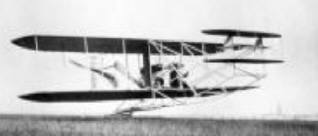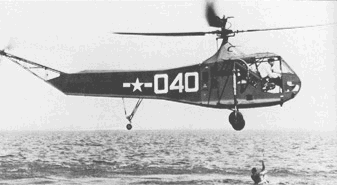 Return to
Return toAviation Answer-Man
Gateway
 Return to
Return to
Aviation Answer-Man
Gateway
 Return to
Return to
The Evolution of Aviation's Most Exotic Technology
Copyright 2004 by Richard Harris
Images courtesy of NASA, Defense Dept.,
U.S. Centennial of Flight Commission,
and the Hiller Museum.
Originally published in In Flight USA
The history of the helicopter is one of the most challenging stories to tell. It is the story of the evolution of a simple idea: unlimited flight -- flying vertically or horizontally, or hovering in mid-air. But as with all things simple, it's not so simple.
The helicopter must challenge many forces that the airplane has scant experience with:
While airplanes and gliders can only fly vertically by first flying horizontally, then turning the entire aircraft upwards, the helicopter must be able to start and finish with vertical flight.
Airplanes and gliders -- "fixed-wing" aircraft -- fly by creating lift with their wings, as a result of moving the entire bulk (including their rigidly-attached wings) through the air. As the wings pass through the air, the "relative wind" generates lift on the wings.
But on a helicopter, lift must be produced by moving the wings, alone, through the air. Hence helicopters -- despite the appearance of being lifted by horizontal propellers -- are more accurately said to be lifted by whirling wings. The main rotor of a helicopter is actually a pair (or more) of long, thin wings -- the main rotor blades -- rotating at high enough speed to generate their own relative wind (and lift), even while the rest of the aircraft, itself, is stationary.
EARLY HELICOPTER IDEAS

Leonardo daVinci sketched his famous "
Helix" -- a screw-shaped airfoil over a wooden framework, spun by the pilot's muscle. But daVinci apparently realized (as with his bird-flapping Ornithopter) that man's muscle-to-weight ratio wouldn't normally be enough for powered flight. But the Helix presaged the name "helicopter" -- from the Latin "helix" (circular shape or direction) and "pteron" (wing).
 The first known vertical-flying contraption is the 2500-year-old "
The first known vertical-flying contraption is the 2500-year-old "
Britain's Sir George Cayley, father of aeronautical engineering in the 1800's, created some giant model ornithopters, which flew as high as 90 feet, and for long distances -- demonstrating the theoretical possibility of vertical flight. By the 1860's, the "flying top," in various forms -- typically, a rotor launched by pulling on a string wound around its shaft -- became a popular toy. Some adults built massive ones, powered by steam, compressed air, springs, or stretched rubber. But none -- it seems -- carried a man aloft.
Putting power to the principle, Britain's W.H. Phillips made a
powered ornithopter model, spewing steam from the rotor tips for propulsion -- and it actually flew, the first mechanically propelled rotorcraft to fly. Italian engineering professor Enrico Forlanni managed to fit a quarter-horsepower steam engine to another model. In 1878, it flew to 40 feet, and hovered there for up to 20 seconds.But -- as with developments in airplanes -- no suitable power source could be found to power it. Early tinkerers saw the idea as possibly delivering an aerial observation and reconnaissance platform, of "great military value." But neither the models they created, nor the prospective full-size designs, could provide sufficient lift. The overriding problem was a lack of sufficient power, in a light enough engine.
To develop an
adequate engine, with a big enough power-to-weight ratio for flight, inventor Thomas Edison (famous for the light bulb and phonograph), tinkered with a lightweight, "explosive engine" -- impregnating tickertape with gunpowder, and squeezing strips of it tightly between metal wheels (to seal in the combustion) into a combustion chamber, where it would be ignited electrically. At first, it worked. But the combustion eventually backfired up through the rollers and ignited the whole roll of "fuel" tape. The mighty explosion drove Edison to quit the idea altogether -- though he later declared "whatever progress the airplane might make, the helicopter will [be the topic of] advanced students of aeronautics".PIONEERS
The Wright brothers had owned a Chinese top, given by their father, back in 1878. But they thought the helicopter idea "more difficult" than glider-flying demonstrated by Cayley and others, and turned away from rotary wings.

In 1908, Emile Berliner, inventor of the "gramophone" (earliest device for recording sound), differed with the Wright brothers' approach. "The way to fly," he insisted "is straight up." Aided by J. Newton Williams, Berliner developed a coaxial helicopter -- that used twin "
co-axial contra-rotating rotors." By rotating in opposite directions, on the same shaft (with internal gearing), they each canceled out the torque of the other, keeping the helicopter from spinning helplessly out of control. Their craft could lift its own weight, though not a pilot's. They would later, in 1924, produce one of the first vertically flyable piloted aircraft -- a sort of biplane with rotors on the wingtips.

But, before Berliner, came the two French firsts:
By the early 1900s, before World War I, the Age of Invention was reaching its zenith. With the airplane now thoroughly "invented," there was a passion for all things flying, and the helicopter idea, well, took off -- especially in Europe.
In France, engineers Louis and Jacques Breguet, from a famed clockmaking family, built a huge framework contraption made up of what looked like four windmills laid on the ground (above, right), with their bases linked around an engine. September 19, 1907 (some say August 24), the fragile collossus, with a total of 32 whirling wings, actually lifted off the ground, and hovered for a few seconds in ground effect -- but could only be controlled by daring volunteers on the ground, gripping ends of the framework, as the rotors slashed through the air just above their heads. Despite repeated efforts, the impracticality of the idea led Breguet to abandon it -- taking up fixed-wing aircraft development, as one of France's most important plane-makers, eventually creating the great airline Air France.
Another Frenchman, Charles Renard, in 1904, had conceived of
And in 1906, Italy's Gaetano A. Crocco had patented " These two methods eventually would become critical to modern helicopter design.
Crocco also discovered a basic problem of rotorcraft:
In 1909, young Russian engineer Igor Sikorsky tried to fly a wooden helicopter built along the same coaxial scheme as Berliner & Williams' first. But this first "Sikorsky" aircraft failed, for lack of better rotors and a bigger engine (he was stuck with only 25 horsepower). Sikorsky, too, abandoned the helicopter to seek his fortune in airplanes, eventually becoming a leading architect of giant airplanes. Fleeing the Communist revolution in 1917, he came to the U.S. and became the master architect of giant flying boats. But the helicopter idea would come back to him, in a decisive way, a generation later.

 The following November, fellow Frenchman Paul Cornu flew a helicopter that had some promise of controlled free flight. Smaller than Breguet's beast, it used a pair of paddle-like rotor blades projecting from each of a pair of horizontal spoked wheels. The wheels were spun by a long belt run around their rims, from the small hub emanating from the motor's transmission. This first "tandem rotor" helicopter not only could hover, but could actually move back and forth a bit, propelled by downwash directed by a couple of simple vanes -- one under each rotor -- which deflected some of the downwash for "
The following November, fellow Frenchman Paul Cornu flew a helicopter that had some promise of controlled free flight. Smaller than Breguet's beast, it used a pair of paddle-like rotor blades projecting from each of a pair of horizontal spoked wheels. The wheels were spun by a long belt run around their rims, from the small hub emanating from the motor's transmission. This first "tandem rotor" helicopter not only could hover, but could actually move back and forth a bit, propelled by downwash directed by a couple of simple vanes -- one under each rotor -- which deflected some of the downwash for " Other Russians, though, were making a difference. K. A. Antonov (later master of giant Soviet airplanes) built a 1910 helicopter similar to Sikorsky's. Moscow student Boris Yuriev created a 1911 helicopter that pioneered
Other Russians, though, were making a difference. K. A. Antonov (later master of giant Soviet airplanes) built a 1910 helicopter similar to Sikorsky's. Moscow student Boris Yuriev created a 1911 helicopter that pioneered
Back at the coaxial twin-rotor idea, though, the Spanish Marquis de Pescara created the first helicopter that was truly "manageable." His Pescara No.3 looked like a tractor dangling from a horizontal windmill. But it actually flew, and incorporated modern flight technology:

In 1922-1923, the de Bothezat craft surprised everyone by performing respectably. It even carried the first helicopter passengers -- three volunteers clinging to the craft's rigging -- as it hovered about, a mere 10 feet above the ground. It also performfed the
In May of 1924, Frenchman Etienne Oehmichen, went one better, with a modernized version of the old Breguet contraption, making the
Meanwhile, airplanes were doing great things, lifting off grass fields in a few hundred feet, and roaring up into the skies at speeds over 150 miles per hour, to distant places at unlimited altitudes, commonly carrying passengers and other substantial loads. Though vertical flight was still the domain of the helicopter, real progress seemed to belong to the airplane.
THE AUTOGYRO
How could the helicopter compete? By joining forces with the airplane, as it turns out. In 1920, the Spanish aircraft designer Juan de la Cierva lost the prototype of one of his large airplanes, when a foolish military pilot stalled it stunting near the ground. Cierva thought there should be some way that a plane could keep aloft when the engine quit, or the craft ran out of airspeed. The idea of whirling wings seemed promising. Cierva added a helicopter's rotor to an airplane, to produce the "
Rather than spinning the rotor with engine power, the autogyro was designed to fly forwards like an airplane (it even had short, fixed wings), until the air began to drag on the rotor, spinning it without any mechanical drive system ("
And it flew.
While wings provided much of the autogyro's lift, the big rotor provided the quick and essential lift to make for short takeoffs, and even shorter -- even vertical -- landings. Some autogyros didn't even use wings at all. And no "anti-torque" or "contra-rotating" rotor was needed, because the engine wasn't turning the rotor -- the air was.
But the first autogyro was destroyed in an accident, when it rolled over on its side during taxiing. Cierva had become the first person to move fast enough with a rotor to discover -- quite unexpectedly -- the extent to which
The cure, it turned out, was to apply the lessons learned from airplane "dihedral" -- an airplane wing's upwards tilt towards the wingtips, which keeps airplanes stable in flight, resisting roll. The rotor blades of a flat, horizontal rotor, had a tendency to "
At the same time, Cierva fitted another hinge, a vertical "
The greater drag on the advancing blades would cause them to rock back on the drag hinge ("lag") -- slowing their progress, and airspeed, and reducing their excess lift. The lesser drag on the retreating blades would cause them to swing forward more aggressively ("lead") under driveshaft pressure and centrifugal force -- increasing their airspeed and lift.
When the autogyro bounced on rolling landings, though, the flapping, lagging and leading blades tended to set up a severe rhythmic oscillation that could tear the craft apart from "
Now Cierva had -- somewhat unintentionally -- resolved all the major remaining design problems with the helicopter rotor system.
To shorten takeoffs, he hooked a
However Cierva's dandy machines were not intended for prolonged vertical flight, and therefore couldn't perform the key missions which would initially bring special value to the helicopter: vertical hoisting and lowering of heavy loads, and hovering rescue. For that, a REAL helicopter, incorporating Cierva's ideas, and those of his predecessors, along with more refined machinery and structure, would be required.
In Europe, many folks were hard at work developing various helicopter ideas, either directly, or through evolutions of the autogyro. These included Italy's d'Ascanio, who flew a
Helicopters were getting out of ground effect, carrying loads, and traveling long distances. The helicopter was becoming a practical machine.
In the U.S., Igor Sikorsky's flying boats were slowly being eclipsed by long-range landplanes. His parent company, United Aircraft, turned him loose on the idea of the helicopter. They were not disappointed. The Russian-American dove into the business with the passion of a parent, and the savvy of a skilled, experienced airplane maker.
By May 1940, he'd pioneered the
In its final form, the VS-300 was very nearly a practical helicopter.
[NOTE: for more commentary and photos on the Sikorsky VS-300 and R-4, see the article "The Sikorsky R-4 Helicopter," in the Eight Great Aircraft, section of this website.]
While various rotor technologies have been tried, from
 And Russian immigrant Professor George de Bothezat -- an egotistical and tempermental "mad Russian" scientist, who was the world's acknowledged expert on rotorcraft design theory, also fled the bloody Communist revolution, for the U.S. He persuaded the U.S. Army into hiring him to build a helicopter for them at their experimental flight technology center at McCook Field, in Dayton, Ohio. In secrecy, Bothezat, built America's first military helicopter along the same lines as the Breguet giant, but added several propellers for various flight-control purposes.
And Russian immigrant Professor George de Bothezat -- an egotistical and tempermental "mad Russian" scientist, who was the world's acknowledged expert on rotorcraft design theory, also fled the bloody Communist revolution, for the U.S. He persuaded the U.S. Army into hiring him to build a helicopter for them at their experimental flight technology center at McCook Field, in Dayton, Ohio. In secrecy, Bothezat, built America's first military helicopter along the same lines as the Breguet giant, but added several propellers for various flight-control purposes.

 By mounting horizontal "
By mounting horizontal " Cierva's machines were enormously popular during the late 1920's to mid-1930's, and were used for all kinds of things, including European military operations, and American urban air mail express service (from suburban airports to the rooftops of city centers), and other challenging and creative applications. Amelia Earhart became one of the autogyro's biggest promoters, and most experienced test pilots, for an American manufacturer. Many other manufacturers, at home and abroad, began to copy them.
Cierva's machines were enormously popular during the late 1920's to mid-1930's, and were used for all kinds of things, including European military operations, and American urban air mail express service (from suburban airports to the rooftops of city centers), and other challenging and creative applications. Amelia Earhart became one of the autogyro's biggest promoters, and most experienced test pilots, for an American manufacturer. Many other manufacturers, at home and abroad, began to copy them.
 VIABLE HELICOPTERS
VIABLE HELICOPTERS
 Louis Breguet came back to the helicopter, with a fine-performing coaxial twin-rotor design, his
Louis Breguet came back to the helicopter, with a fine-performing coaxial twin-rotor design, his  German professor Heinrich Focke -- whose
German professor Heinrich Focke -- whose 
SIKORSKY "FINISHES" THE JOB
 World War II brought the development of the VS-300 into the fully operational REAL helicopter, the enclosed-cabin
World War II brought the development of the VS-300 into the fully operational REAL helicopter, the enclosed-cabin  Other designs have been tried, from the heavy-lifting
Other designs have been tried, from the heavy-lifting 
 ___________________
___________________